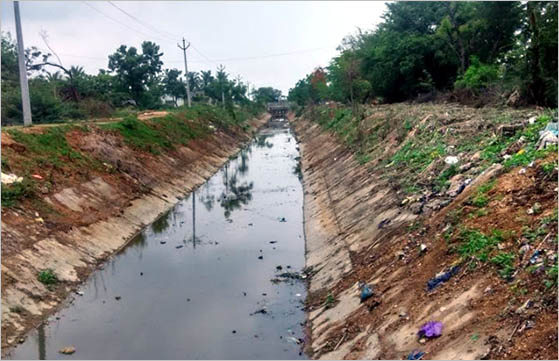Ingenious Industrial Wastewater Treatment Solutions: Shielding the Atmosphere
Just How Fluid Garbage Disposal Works: A Detailed Review of Strategies and Technologies Utilized

Introduction of Liquid Waste Types
The complexity of liquid waste types requires a thorough understanding of their features and implications for disposal. Fluid waste can broadly be classified into several kinds, consisting of commercial, metropolitan, agricultural, and contaminated materials. Each group displays unique residential properties, calling for particular monitoring techniques to reduce environmental and health and wellness risks.
Industrial liquid waste originates from producing processes and frequently contains a series of contaminants, such as heavy steels, solvents, and organic compounds. Community liquid waste, largely comprising wastewater from families and industrial facilities, has raw material, nutrients, and microorganisms (industrial wastewater treatment). Agricultural liquid waste, consisting of runoff from ranches, may have plant foods, pesticides, and animal waste, posturing risks to water high quality and communities
Dangerous fluid waste is defined by its poisoning, sensitivity, or prospective to cause harm. Recognizing these diverse liquid waste types is crucial for establishing reliable disposal approaches and guaranteeing conformity with ecological regulations.
Physical Therapy Methods

Screening is the first action, where larger bits and particles are eliminated from the fluid waste using screens or grates. In sedimentation tanks, much heavier fragments resolve at the base, creating a sludge layer, while the made clear fluid can be additional dealt with.
Filtering is an additional crucial approach that involves passing the liquid via permeable materials, such as sand or membrane layers, to capture smaller sized bits. This step boosts the high quality of the fluid, making it suitable for subsequent treatment procedures.

Chemical Therapy Strategies
Chemical therapy techniques are essential for successfully handling fluid waste, especially in attending to dissolved and colloidal impurities that physical methods might not appropriately get rid of. These methods use different chemical agents to neutralize, precipitate, or transform hazardous compounds right into less dangerous forms.
One typical approach is coagulation and flocculation, where chemicals such as alum or ferric chloride are included in promote the aggregation of suspended particles. This process improves sedimentation, permitting simpler removal of the resulting sludge. Furthermore, oxidation procedures, utilizing agents like chlorine or ozone, are employed to damage down complicated natural compounds and pathogens, rendering the waste more secure for discharge or more treatment.
Neutralization is one more vital strategy, which changes the pH of acidic or alkaline waste streams to neutral degrees, stopping potential damage to downstream systems and the setting. Additionally, progressed oxidation processes (AOPs) make use of combinations of oxidants and ultraviolet light to break down relentless toxins, achieving a greater level of treatment efficiency.
Biological Therapy Processes
Biological treatment procedures play a crucial duty in the monitoring of fluid waste by utilizing microbes to break down raw material and minimize contaminant degrees. These procedures can be generally classified right into aerobic and anaerobic treatments, each employing specific microbial areas to achieve effective waste deterioration.
Cardiovascular therapy includes using oxygen to help with the break down of natural materials by germs. This procedure is commonly implemented in turned on sludge systems, where oygenation tanks offer a conducive atmosphere for microbial growth, bring about the oxidation of click now organic pollutants. The resultant biomass can be divided from dealt with effluent through sedimentation.
In comparison, anaerobic therapy occurs in the absence of oxygen, counting on various bacteria to damage down natural matter. This approach is specifically useful for high-strength waste, as it generates biogas, a renewable resource source, while reducing sludge manufacturing. Technologies such as anaerobic digesters are often employed in industrial and local applications.
Both anaerobic and cardiovascular organic therapies not only minimize the environmental influence of fluid waste but also promote resource healing, making them crucial parts of lasting waste administration techniques. Their effectiveness, performance, and adaptability sustain their extensive execution throughout numerous markets.
Arising Technologies in Disposal
Ingenious methods to liquid garbage disposal are rapidly evolving, driven by developments in technology and an increasing emphasis on sustainability. Among these emerging technologies, membrane layer bioreactors (MBRs) have actually acquired grip for their ability to integrate biological treatment with membrane purification, resulting in top quality effluent that can be reused in numerous applications. MBRs make it possible for smaller sized footprints and a lot more effective procedures compared to typical systems.
Another promising advancement is making use of anaerobic digestion incorporated with nutrient recuperation modern technologies, which not only treats liquid waste but additionally produces biogas and recoups useful nutrients like nitrogen and phosphorus. This twin advantage enhances source performance and lowers environmental impact.
In addition, advanced oxidation procedures internet (AOPs) are being embraced for the deterioration of complex natural pollutants. These methods use powerful oxidants and catalysts to damage down impurities at the molecular degree, providing a highly reliable remedy for tough waste streams.
In addition, the combination of expert system and artificial intelligence in waste management systems is enhancing functional effectiveness and predictive upkeep, leading to lowered prices and improved ecological compliance. These innovations show a significant shift in the direction of more lasting and reliable liquid waste disposal practices.
Final Thought
In verdict, reliable liquid waste disposal demands an extensive understanding of different techniques and modern technologies. By continually advancing these methodologies, it becomes feasible to resolve the expanding obstacles associated with liquid waste, inevitably adding to ecological security and resource recovery.
Fluid waste disposal is an important aspect of environmental management, needing an extensive understanding of numerous Learn More Here techniques and modern technologies tailored to different waste kinds. Liquid waste can generally be classified right into several kinds, including industrial, local, agricultural, and hazardous waste. Agricultural fluid waste, including runoff from farms, may have fertilizers, chemicals, and animal waste, posing dangers to water top quality and environments.
Various physical treatment techniques play an essential role in handling fluid waste efficiently - industrial wastewater treatment.In verdict, reliable fluid waste disposal demands a thorough understanding of numerous methods and technologies